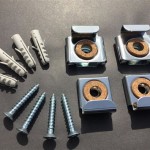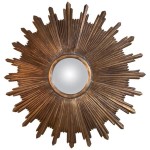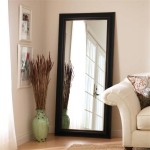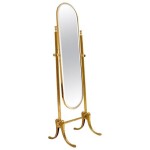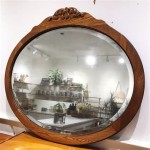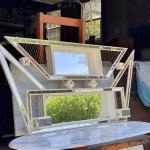```html
The Alluring Elegance of Antique Cheval Floor Mirrors
Antique cheval floor mirrors stand as enduring testaments to craftsmanship and design ingenuity. These full-length mirrors, characterized by their supporting frame that allows them to tilt, offer not only a practical function but also a significant aesthetic contribution to any living space. Their history, construction, and stylistic variations reflect the evolving trends of furniture design across centuries, making them highly sought-after pieces for collectors and interior design enthusiasts alike.
The term "cheval" originates from the French word for "horse," a reference to the mirror's supporting structure resembling a horse's frame. This free-standing design distinguishes it from wall-mounted mirrors, offering greater flexibility in placement and allowing for full-body reflection in various angles. The popularity of cheval mirrors surged in the 18th and 19th centuries, coinciding with advancements in glass manufacturing and a growing emphasis on personal grooming and fashion.
Understanding the value and authenticity of an antique cheval floor mirror requires a comprehensive evaluation of its components, including the mirror glass, the frame, and any decorative elements. Careful examination of these aspects can reveal clues about the mirror's age, origin, and potential restoration needs.
Identifying Key Characteristics of Antique Cheval Mirrors
A crucial step in appreciating and evaluating an antique cheval mirror involves recognizing its defining characteristics. These features provide insight into the mirror's age, style, and craftsmanship. Distinguishing between genuine antiques and later reproductions requires a meticulous assessment of several factors.
Firstly, the mirror glass itself can offer significant clues. Early glass manufacturing techniques often resulted in imperfections such as bubbles, waves, or slight distortions. While perfectly smooth and flawlessly reflective glass may be desirable in modern mirrors, the presence of these minor flaws can be indicative of older glass. Furthermore, the backing of the mirror can reveal its age. Historically, mirror backings were often made of silver nitrate, which tends to tarnish over time, creating a mottled or speckled appearance. Modern mirrors, on the other hand, typically use aluminum, which is less prone to such degradation.
Secondly, the frame's construction is a vital indicator of the mirror's age and origin. The type of wood used, the joinery techniques employed, and the style of carving or ornamentation can all point to a particular period or region. For instance, mahogany was a popular choice in the 18th and 19th centuries, while oak and walnut were also frequently used. Hand-carved details, such as floral motifs, geometric patterns, or classical figures, are often found on antique cheval mirrors, reflecting the artistic sensibilities of the time. The precision and intricacy of these carvings can provide valuable insights into the skill of the craftsman who created them.
Lastly, the tilting mechanism of the cheval mirror is an important feature to examine. The hardware used to support and adjust the mirror's angle can vary depending on the age and style of the piece. Older mirrors may feature hand-forged iron or brass fittings, while later examples may incorporate more mechanized components. The condition and functionality of the tilting mechanism can also affect the mirror's overall value and usability.
Exploring Different Styles and Periods
Antique cheval mirrors encompass a wide range of styles, each reflecting the prevailing aesthetic trends of its respective era. From the ornate grandeur of the Baroque period to the neoclassical elegance of the late 18th century, these mirrors offer a glimpse into the diverse tastes and preferences of the past.
Baroque cheval mirrors, popular in the 17th and early 18th centuries, are characterized by their opulent ornamentation and dramatic curves. These mirrors often feature elaborate carvings, gilded surfaces, and intricate marquetry. The use of rich materials such as ebony, ivory, and tortoiseshell was also common. The overall effect is one of extravagance and grandeur, reflecting the wealth and power of the aristocracy.
During the Rococo period, which followed the Baroque, cheval mirrors became lighter and more playful in their design. Asymmetrical curves, delicate floral motifs, and pastel colors were characteristic of this style. Rococo mirrors often featured whimsical details such as cherubs, shells, and scrolls. The emphasis was on elegance and refinement, rather than the overt display of wealth seen in the Baroque era.
The neoclassical style, which emerged in the late 18th century, marked a return to classical forms and proportions. Neoclassical cheval mirrors are characterized by their clean lines, symmetrical designs, and restrained ornamentation. Common decorative elements include fluted columns, Greek key patterns, and laurel wreaths. The use of mahogany and other hardwoods was prevalent, and the overall effect is one of understated elegance and sophistication.
The Victorian era saw a revival of various historical styles, including Gothic, Renaissance, and Rococo. Victorian cheval mirrors often feature a combination of these influences, resulting in a highly ornamental and eclectic aesthetic. The use of dark woods, such as walnut and rosewood, was common, and details such as beveled glass, tufted upholstery, and ornate metalwork were often incorporated.
Art Nouveau cheval mirrors, popular in the late 19th and early 20th centuries, are characterized by their flowing lines, organic forms, and stylized floral motifs. These mirrors often feature asymmetrical designs and the use of materials such as glass, metal, and wood. The overall effect is one of naturalism and elegance, reflecting the Art Nouveau movement's emphasis on beauty and craftsmanship.
Caring for and Restoring Antique Cheval Mirrors
Preserving the beauty and value of an antique cheval mirror requires proper care and, in some cases, professional restoration. Understanding the appropriate techniques for cleaning, repairing, and maintaining these delicate pieces is essential for ensuring their longevity.
Cleaning an antique cheval mirror should be done with caution and sensitivity. Avoid using harsh chemicals or abrasive cleaners, as these can damage the mirror glass or the frame's finish. Instead, use a soft, lint-free cloth dampened with a mild soap solution to gently wipe the mirror's surface. Be sure to dry the mirror thoroughly to prevent water spots or streaks.
The frame of the cheval mirror may require more specialized cleaning techniques, depending on the type of material and finish. Wood frames can be cleaned with a soft brush or cloth to remove dust and debris. If the frame has a polished or varnished finish, a furniture polish specifically designed for antiques can be used to restore its luster. Metal frames can be cleaned with a metal polish to remove tarnish and corrosion.
Significant repairs or restorations should always be entrusted to a qualified professional. Attempting to repair damaged glass, replace missing hardware, or refinish the frame without the necessary expertise can potentially damage the mirror and diminish its value. A professional restorer will have the knowledge, skills, and tools to perform these tasks safely and effectively.
When considering restoration, it is important to strike a balance between preserving the mirror's original character and restoring its functionality and appearance. Excessive restoration can sometimes detract from the mirror's value, while neglecting necessary repairs can lead to further deterioration. Working with a reputable restorer who understands the nuances of antique furniture is crucial for achieving the best possible outcome.
Proper storage and handling are also essential for preventing damage to an antique cheval mirror. Avoid placing the mirror in direct sunlight or near sources of heat or moisture, as these conditions can cause the glass to crack or the frame to warp. When moving the mirror, be sure to lift it carefully and support it from the base to prevent strain on the frame and tilting mechanism. Consider using protective padding or wrapping to prevent scratches or dents during transport.
Finally, regular inspection of the mirror can help identify potential problems early on. Check for loose joints, cracks in the glass, or signs of woodworm infestation. Addressing these issues promptly can prevent them from escalating and potentially causing more significant damage.
```
Cheval Mirrors Foter Floor Mirror Victorian Wall

Antique Italian Carved Venetian Parcel Painted Gilt Dressing Cheval Floor Mirror

19th Century Cheval Floor Mirror Louis Xvi Whitewashed Standing Greenwich Living Design

Antique Cheval Mirrors

Vintage Cheval Mirror Oak Standing Floor Tilting Vanity Boudoir Dressing Room Shabby Chic Traditional

Vintage French Country Pine Cheval Floor Mirror Firebird Furniture

Antique Cheval Mirrors

Antique 19th Century Belgian Liegoise Carved Oak Louis Xv Cheval Or Floor Mirror For At 1stdibs Victorian

Full Length Cheval Mirror Floor Standing Dressing Yola Gray Antiques

Antique French Style White Finished Cheval Mirror Mirrors Furniture Bedroom
